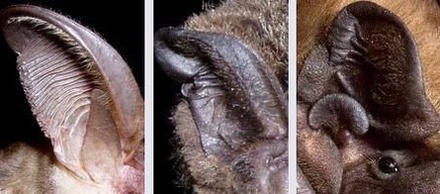Adaptations
Bat species in Slovakia feed on night active insects. The flying is possible by the skin membrane stretched over the fingers of forelimbs, hind limbs and tail. They move on the ground or other firm surface by crawl. When resting, they hang down with head down.
Back around 1700, an Italian researcher found out that bats are able to fly safely in the dark, however not with plugged ears, because bats are adapted – they use echolocation.

Special shape of ears and ear-cover enable bats to catch the reflection of ultrasonic waves sent from mouth or nose. Signal reflected by an obstacle or a prey gains a specific character. The most species send the signal by mouth (frequency is typically modulated in the broadband – FM), some by nose (mostly horseshoe bats with a quasi-constant frequency in a narrowband – qCF). Bats send the sound in the space each 50 millisecond with the frequency from 20 to 110 kHz. The lowest frequency of around 22 kHz makes Common noctule and the highest frequency of around 110 kHz makes The lesser horseshoe bat. On this way, bats have a perfect orientation in surroundings and can safely fly in the darkness, in high levels and in the crowns of trees and to hunt.

It is not only sound what bats use – they have eyes and even can see with them quite well in the gloom. Bats are active during night; however they can be seen also during the day. Each species is specific in its voice frequency, intensity and character of the tone and it enables to determine the bat species during the flight without disturbing them or catching by ultrasonic detector devices. This determination method is however more demanding on field experience and technical equipment.
